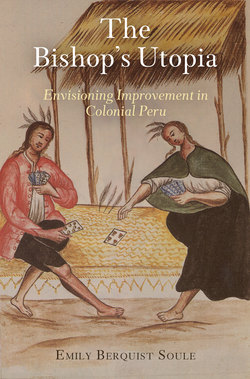Читать книгу The Bishop's Utopia - Emily Berquist Soule - Страница 13
ОглавлениеCHAPTER 3
Imagining Towns in Trujillo
Three miles outside the city of Trujillo lies what Martínez Compañón called “the ruins of a town of the Chimú kings,” a UNESCO world heritage site today known as Chan Chan. The Chimú people who built it predominated on Peru’s north coast from the tenth century until the arrival of the Inca in the 1460s. At the height of their power, they controlled a vast territory stretching from Peru’s border with Ecuador to the Chillón Valley, north of Lima. Chan Chan was in its day the largest city in all the Andes, with a population thought to have reached 40,000 at its height. By the late eighteenth century, the ruins were most notable for their crumbling huacas, or burial mounds, looming in the distance. Their dusty walls were scarred with holes that were the handiwork of the infamous grave robbers known as huaqueros. Pilfering precious metals, ceremonial costumes, and other artifacts from native burial sites was big business in colonial Peru: in the sixteenth century, one individual reportedly unearthed almost 300,000 castellanos’ worth of gold and silver from just one huaca; in 1602, an enterprising group of men from Trujillo tried to divert the Moche River directly into the path of the pyramid at the Huaca del Sol so that water would cause it to cave in and expose the gold inside. But the most valuable find at Chan Chan was made in 1558–1559, when a down-on-his-luck townsman named Antonio Zarco unearthed treasures so brilliant that they set off a looting fever that eventually produced 700,000 castellanos worth of gold pieces and even more disagreement about who had rightful dominion over the wealth.1
Although these early missions were more focused on plunder than on archaeological investigation, more academically minded Europeans soon followed their avaricious predecessors to the pre-Hispanic ruins of the northern Andes. As early as 1631, Antonio de la Calancha investigated the nearby Moche sites of Huaca del Sol and Huaca de la Luna. By the eighteenth century, archaeological notations had become almost de rigueur in travelers’ reports from northern Peru. Frenchman Charles Marie de La Condamine and Spanish bureaucrats Jorge Juan and Antonio Ulloa wrote about and mapped the Inca ruins at Hatun Cañar near Cuenca, Ecuador. Spanish botanists Hipólito Ruiz and José Pavón devoted portions of their Crown-sponsored botanical expedition to archaeological investigation. Their work was not anomalous: as the Spanish sought visual and material data that could be shared with experts throughout the Atlantic world, they increasingly came to value archaeological research as a method of understanding cultures that almost three hundred years after contact remained, for the most part, impenetrably foreign. Physical samples of pottery and tools, as well as maps of buildings and engineered changes to the environment were useful data that could be transported great distances and shared with the broader scientific community. Such research was part of a broader Spanish Bourbon fever for surveying ancient sites that began during Charles III’s time in Naples (1735–1759), when scholars excavated the great ash-covered cities of Herculaneum and Pompeii. By 1777, the Crown was so intrigued by ancient sites that the Royal Cabinet of Curiosities in Madrid put out an official call for antiquities taken from pre-Hispanic tombs and ruins in America.2
Although the only written records of Martínez Compañón’s participation in the archaeological craze of the Bourbon Spanish empire are the inventories of archaeological objects that he sent to Spain in 1788 and 1790, a detailed map of Chan Chan (see Plate 12) in volume 9 of his Trujillo watercolors indicates that he and his assistants spent a good deal of time at this important site, carefully demarcating the foundations of buildings and the location of tombs, as well as houses, piles of metal scraps, the walls that separated the complex from the desert around it, and even an underground tunnel that ran to the hills in the distance.3
Contemporary visitors to Chan Chan find a site that is quite similar to what late eighteenth-century archaeologists would have encountered. Hand-molded walls of golden cascajo (gravel and mud) adobe are shaped into sophisticated high-relief patterns where stylized pelicans, fish, and monkeys play alongside ocean waves. The air within the compound is fresh and cool despite the exterior temperature; the walls ingeniously channel the cooling sea breezes from the nearby Pacific Ocean. In many places, the contours have softened from the torrential rains that torment the region in years of heavy rainfall, wearing away the corners. But still visible are the fading outlines of the delicately spined spondylus shells carved into the wall by Indian craftsmen. The Chimú celebrated these shells as a demonstration of their imperial prowess—the spondylus were harvested in the distant north of their kingdom, in what is now Ecuador, and carried south to Peru.
